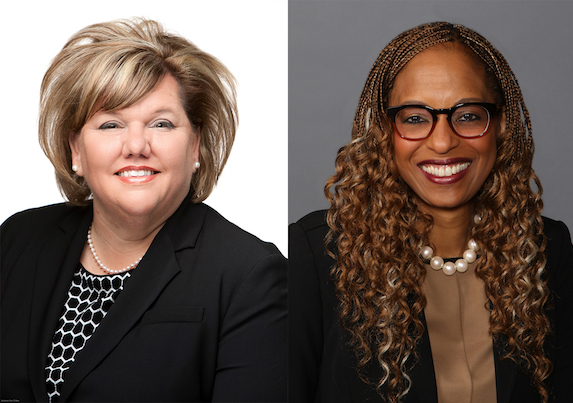8 ways to enhance workplace inclusivity through physical space and design

Nonnie Shivers and Michelle P. Wimes of Ogletree, Deakins, Nash, Smoak & Stewart.
While it’s not far-fetched to speculate that changing office temperatures more than a few degrees in either direction could turn the thermostat into courtroom evidence, have entities that are committed to inclusion in the workplace considered whether a rise from 70 to 72 degrees might be enough to keep everyone more comfortable and increase overall productivity?
The battle over the thermostat is alive and well at home and at work. Facebook co-founder and CEO Mark Zuckerberg claims to keep his office at a chilly 59 degrees, and actress Cynthia Nixon attempted to set the temperature of the room where she participated in a debate as one of the candidates for governor of New York to what her campaign staff referred to as a “perfectly reasonable” 76 degrees.
Given that the average American spends an estimated 90,000 hours at work in their lifetime, it is not surprising that a 2018 CareerBuilder survey of over 1,000 full-time employees found that 46% of employees think their office is too hot or cold, and 15% of employees have argued with co-workers about the office temperature.
Povl Ole Fanger began developing the thermal comfort model” in the 1960s to determine the ideal indoor temperature. At the time, Fanger based his calculations on the metabolism of a 40-year-old, 154-pound man wearing a business suit. Based off this model, most offices are set around 70 degrees.
As many recent media stories have accurately pointed out though, the average workplace in 2019 is far more diverse than Fanger’s model. Women’s metabolisms and thermal demands are different, and they now make up about half of the labor force.
If you’ve got the equivalent of polar bears living in Phoenix in your office or meeting, perhaps the consideration is to have a supply of inexpensive (yet clean) blankets or sweaters to offer those who are not comfortable with the walk-in cooler temperature preferred by your group.
Conversely, part of the solution might also include budgeting for personal fans for those who want them in their workspaces for temperature or even white noise to maximize their productivity.
At Ogletree, Deakins, Nash, Smoak & Stewart, we made many changes in the last year after being one of the first firms to sign the ABA’s Well-Being Pledge and wanting to be more progressive on these issues. As firm leaders who both happen to be women and minorities, we have become personally invested in ensuring our firm offers these inclusive alternatives.
In addition to discussing office temperatures, other physical space and design considerations, as well as programmatic design, could also be part of a company’s larger diversity and inclusion efforts. Check out some of these ideas that your firm might include.
Alcohol-free events
In the legal industry, where alcohol abuse is extremely prevalent, nonalcoholic events are a healthy option that also promote inclusiveness for employees who do not drink (whether generally or simply while on business). Instead of a cocktail hour, offer a 5K walk/run. Instead of a welcome reception with an open bar, host a variety of wellness welcome groups with different inclusive offerings, including yoga, meditation, mindfulness and other activities.
Inspired by the ABA’s Well-Being Pledge and its commitment to improving the substance abuse and mental health landscape of the legal profession, Ogletree’s annual attorney retreat in 2019 will kick off with a “Wellness Welcome” program consisting of multiple sessions focused on yoga, stretching, self-defense and stress management, as well as its annual memorial 5K walk/run and a relaxation lounge stocked with healthy drinks and snacks.
Built-in meeting breaks
For meetings that last longer than an hour, consider building in fixed break periods into the agenda. Ogletree intentionally incorporates wellness breaks into its in-person board of directors meeting, announcing set times in advance. This thoughtful preplanning allows its directors to plan and utilize the breaks most effectively. One director uses the morning wellness break to cross time zones and greet her young children via video chat to kick off their day.
Accomplishing the goals of a successful meeting is impacted when an employee has to leave or miss parts of a lengthy meeting because of a hidden disability (e.g., irritable bowel syndrome, etc.), because of a personal need (e.g., menstruation), or they are lactating and have to pump breast milk. Fixed break periods allow employees to take care of their physical and often highly personal needs without being singled out or simply standing out.
Walking meetings
When the weather permits, consider hosting walking meetings where employees get exercise and fresh air. However, be sure to consider if such meetings allow for full participation of all attendees, including based on temperature, physical needs or comfort, and physical ability (hidden or visible). Ogletree’s Los Angeles office, for example, has hosted walking meditation sessions outside using the green space across the street from its office location.
Ambient environment enhancements
Adding more office plants and windows (or visible light and alternative, natural light sources) for all employees, repainting walls, and using apps and other smart technology to individualize workspaces to meet personal preferences and needs, including lighting, heating and glare, may ultimately have small costs but large potential impacts. Consider providing ultraviolet light for those who may not have access to natural light, as ultraviolet rays are proven to improve mood and stress.
Alternative and intentional space options
While numerous states and cities require various iterations of dedicated spaces to pump breast milk, consider dedicated space even where such requirements do not exist. Consider quiet reflection spaces where individuals with a need to be in a dark, private and/or quiet space for a short time (e.g., migraine sufferers) could benefit from a small, dedicated space with a comfortable chair, footrest and control of lighting.
Designate a meditation or wellness room for people to use to de-stress or calm themselves. Consider providing small-use exercise equipment (e.g. resistance bands, back rollers, etc.) in those rooms. In an effort to encourage and inspire creativity, we may provide spaces that are conducive to collaboration and communication.
Conversely, having spaces that allow for quiet reflection equally allow the creative juices to flow. As a small but meaningful consideration for workspaces, also consider the intentionality of naming conference rooms or workspaces to reflect and build your culture while enhancing inclusivity.
In Ogletree’s Kansas City, Missouri, office, a conference room space is converted to a dedicated wellness space once weekly when a massage therapist is brought in to offer on-demand massages for staff members. Ogletree’s Los Angeles office offers similar massage therapist services twice monthly while also providing a wellness/lactation room with a small couch and reclining a chair, as well as regular meditation sessions.
Visible displays of inclusivity
Display reading material in the lobby that is relevant to our industry versus clearly gendered options. Likewise, display art, posters, pictures and mementos that are inclusive of everyone. Carefully cast campaigns and images, whether related directly to diversity and inclusion initiatives or not, to be maximally inclusive.
By way of example, Ogletree’s Oklahoma City office features art reflecting the wide variety of professions present across Oklahoma, including gas and oil, farming, construction and other industries, as well as the diverse employee base in these various professions. Ogletree’s Phoenix office features beautiful photographs of the desert and its indigenous people from some of the many recognized Native American tribes in the state of Arizona.
Workstation adjustments
While it may have more impact on office costs, consider the array of workstation adjustments that can enhance workplace inclusivity of all body types, ages and abilities. Ergonomic keyboards and a thorough assessment of workstations and seating could be built into a budget or renovation. Consistent approaches to standing stations for those who prefer to work in this way but have no disability requiring such stations is often a huge added value for hard-working attorneys and staff.
Use design, remodeling and other processes creatively. When Ogletree recently moved into a new space in the West, a thoughtful firm leader exchanged outdated and light-blocking credenzas for standing-desk components for its desks. Invest in adjustable chairs and desks, with storage in reach for all employees.
Design Considerations
Use levers instead of knobs for employees with limited manual dexterity. This includes using the “closed-fist rule,” where handles can be operated with a closed fist, allowing more access. Incorporating private, single-use restrooms when remodeling and designing a new space can enhance employee privacy while also addressing a number of employee concerns and desires, including employees with medical conditions and LGBTQ employees, in particular transgender employees.
There is no one-size-fits-all approach to create an inclusive workplace. Even if the office temperature is not the primary issue, taking small, cost-effective steps and listening to the needs of your employees may boost productivity while furthering inclusivity and minimizing legal risks.
Nonnie Shivers is a shareholder at Ogletree, Deakins, Nash, Smoak & Stewart and was elected to the firm’s board of directors in January 2018. Shivers is a legal thought leader on LGBTQ issues in the workplace and maintains a practice focused on high-level investigations, proactive training, complex multistate advising and solutions-oriented project leadership, and when needed, bet-the-company litigation.
Michelle P. Wimes is the chief diversity and professional development officer at Ogletree, Deakins, Nash, Smoak & Stewart, where she leads the firm’s efforts to attract, develop and advance a diverse group of attorneys across the firm’s national platform of 50-plus offices in the United States, Europe, Latin America and the Caribbean. Wimes also leads the firm’s attorney training and professional development efforts.
ABAJournal.com is accepting queries for original, thoughtful, nonpromotional articles and commentary by unpaid contributors to run in the Your Voice section. Details and submission guidelines are posted at “Your Submissions, Your Voice.”
Your Voice submissions

The ABA Journal wants to host and facilitate conversations among lawyers about their profession. We are now accepting thoughtful, non-promotional articles and commentary by unpaid contributors.

